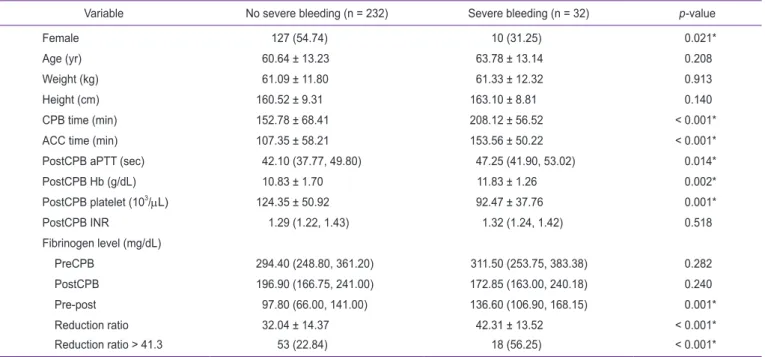Introduction Introduction
Severe bleeding and transfusion after cardiac surgery are as- sociated with various complications, which increase morbidity and mortality [1]. The main causes of bleeding after or during cardiac surgery include preoperative anti-thrombotic medica- tion, residual heparin effects, surgical trauma, platelet dysfunc-
tion, dilution coagulopathy, and hypothermia; the latter three are caused by cardiopulmonary bypass (CPB) [2]. Fibrinogen is a plasma protein that is important for coagulation [3]. A low fi- brinogen level after cardiac surgery is an important indicator of acquired coagulopathy. Fibrinogen levels before and after CPB are correlated with bleeding after cardiac surgery [4-6]. How- ever, the meta-analysis revealed that the correlation between Int J Oral Biol 45:51-57, 2020
pISSN: 1226-7155 • eISSN: 2287-6618 https://doi.org/10.11620/IJOB.2020.45.2.51
Change in fibrinogen levels and severe postoperative bleeding in cardiac surgery
Eun-Jung Kim 1 , Joo-Yun Kim 2 , Hee Young Kim 2 , Boo-Young Hwang 3,4 , Ah-Reum Cho 3,4 , Young-Hoon Jung 4 , Seung-Hoon Baek 3,4 , and Jeong-Min Hong 3,4 *
1 Department of Dental Anesthesia and Pain Medicine, School of Dentistry, Pusan National University, Dental Research Institute, Yangsan 50612, Republic of Korea
2 Department of Anesthesia and Pain Medicine, Pusan National University Yangsan Hospital, Yangsan 50612, Republic of Korea
3 Department of Anesthesia and Pain Medicine, School of Medicine, Pusan National University, Yangsan 50612, Republic of Korea
4 Department of Anesthesia and Pain Medicine, Pusan National University Hospital, Busan 49241, Republic of Korea
Thromboelastography or rotational thromboelastometry, is being increasingly utilized in cardiac surgery of late. However, it is an indirect test and is not available in all centers. Low fibrinogen levels before and after cardiopulmonary bypass (CPB) have been described to be associated with postoperative bleeding in cardiac surgery. This study explored the usefulness of reduction ratio of the fibrinogen levels before CPB (preCPB) and after CPB (postCPB) in predicting postoperative hemorrhage. A retrospective, observational study of adult patients who underwent cardiac surgery with CPB between February 2014 and January 2016 was conducted, which included a total of 264 patients. The fibrinogen levels were measured twice, preCPB and postCPB, and the fibrinogen reduction ratio was acquired [(preCPB − postCPB)/preCPB]. Postoperative blood loss, which was defined as the blood collected from the chest drain for 12 hours following arrival at the intensive care unit, was considered severe if it was more than 1,000 mL. A multivariate analysis showed that fibrinogen reduction ratio, sex, and postCPB platelet count were significantly associated with severe postoperative bleeding. However, the pre- and postCPB fibrinogen levels were not significantly associated with severe bleeding. Furthermore, a fibrinogen reduction ratio of > 41.3% was independently associated with postoperative severe bleeding, with an odds ratio of 3.472 (1.483–8.162). These results suggest that the reduction ratio of pre- and postCPB fibrinogen levels may be utilized in predicting postoperative bleeding.
Keywords: Cardiopulmonary bypass, Fibrinogen, Postoperative hemorrhage
Received April 14, 2020; Revised May 15, 2020; Accepted May 15, 2020
*Correspondence to: Jeong-Min Hong, E-mail: ccarrot@pusan.ac.kr https://orcid.org/0000-0003-3527-555X Copyright © The Korean Academy of Oral Biology
CC
